

|
Back to |
| The Front Page |
| Archives |

|
Golf Croquet World Championship at Leamington Spa
moves the sport towards the cultural mainstream
by Bob Alman; photos courtesy of Jim Houser Posted November 15, 1998 |
The world championship for golf croquet came to Mother England for the first time in early October of 1998, but this is one championship the original masters of the sport were not expected to win. Egypt had crafted its own unique form of croquet following the departure of the English from their country early in the 20th Century. Everywhere else, golf croquet was a trivial game, relegated mostly to novices and lawn parties. But the Egyptians lifted Egyptian Golf Croquet to a higher plateau of precision and competitiveness. So it was no surprise that an Egyptian once again won the Golf Croquet World Championship, at Leamington - especially this particular Egyptian, who had taken the top trophy at the first one, in Milan in 1996.
The surprise was the #2 showing of American Mik Mehas, playing in his first golf croquet tournament. That was surprising, but not shocking, as Mehas, with solid credentials in "Association Croquet", was the highest ranking competitor at Leamington Spa.
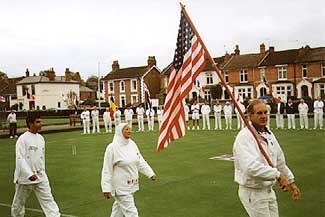
|
| Michael Mehas of Palm Springs, Calfiornia, carries the American flag at the opening ceremonies, along with darkhorse hopes for an American breakthrough in the third Golf Croquet World Championship. |
To prove that the performances of Mehas and Newell were not flukes, one only need point to the fifth-place finish of Giampietro Donati of Italy and the eight-place showing of Peter Payne of Switzerland.
Before Leamington Spa, the Egyptians virtually "owned" the game. By the end of finals day, the brief era of uncontested Egyptian dominance was over, brought to a sudden end by the four scrappy non-Egyptians who joined a quartet from Cairo in the quarter-finals.
The 48 players who took part in the Championship had been nominated by 12 of the 20 member countries of the World Croquet Federation. Allocated places not taken up by eight of the member countries were re-allocated as WCF "wild cards" in consultation with individual national associations. A further five places were allocated to players in qualifying competitions held in Egypt and England. Pre-qualified were the winner and runner-up of the 1997 Championships, Egyptians Salah Hassan and Walid Salah. Reasonable steps were taken to assure the broadest possible participation as well as the highest level of competition. Taking into account member-country allocations, qualifiers, and wild cards, the Egyptians started with more than one quarter of the player spots - 13 of the 48. England, the host country, had another 13, Ireland 5, the U.S. 4, with Switzerland, Italy, South Africa, Palestine, Scotland, Australia, and Belgium taking the rest.
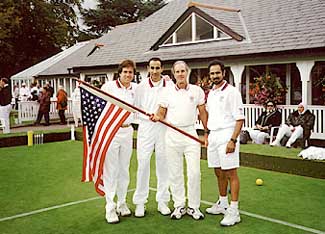
|
| The American team: Jim Houser, Sherif Abdelwahab, Mik Mehas, and Ihab Abdelwahab. |
Block play qualifiers produce few surprises
The format for the qualifying round called for one-game matches in eight blocks of six players each, the top four proceeding to a best-of-three knockout ladder for the 32 qualifiers. The bottom two went into a sixteen- player knockout to determine places 33 to 48. Therefore, the entire tournament wound down in a series of knockout ladders dividing by halves with each round to eventually determine all the places, from #1 through #48. This design assured a full measure of competition for everyone.

|
| Salah Hassan, 1997 winner(left) chats with Khaled Younis, 1998 champion. |
But the block play was not to be a reliable indicator of what was to come in the best-of-three knock-out ladder. The 16-year-old English National Junior Champion, Kristian Chambers, had taken his place in the lineup as the youngest competitor by winning England's qualifying tournament at Kenilworth. With his first round success, he looked likely to engineer some upsets in the knockout ladder. It was not to be.
Conversely, eventual finalist Mik Mehas did not impress in block play. Like Chambers, he was new to the game. Unlike Chambers, he was improving with every game. Egypt's Mohamed Anan, who would eventually gain 6th place, also struggled to take only three wins in his block.
Egyptians cope well with cold and windly English weather
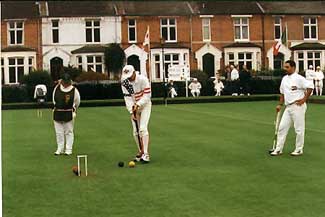
|
| The ref watches Mehas at hoop #4 in the heated semi-final against Egypt's Yasser Esmat. |
The first two days of play ran on time, with the best-of-13-point games averaging 40 minutes. There had been some concern as to whether the one-foot surround of the sunken bowling greens would provide adequate protection from hard-hit balls. Perhaps because there were no mounds or bumps on the well- kept bowling greens to cause an an Egyptian "rocket" to take to the air, the three-foot barriers typical in Egypt were not needed at Leamington to protect the spectators.
Following the blocks, the draw for the 32-player knockout was in a pre- ordained "Ark of Destiny" format. The draw itself was carried out in public, but the designer of the "Ark" - John Jeffrey, Championship Manager - is reportedly the only person who understands its mechanical workings, so we will not explain it.
The first round of the knockout also produced few upsets. Nine of the 13 Egyptians had prevailed, along with three of the four Americans. That left one each in the final sixteen for Italy, Switzerland, Ireland, and England. Peter Payne of Switzerland had demonstrated his improved form with a win over Italy's Andrea Pravettoni; Mik Mehas had started to show what was to come with a win in three games over Hisham Abou Esba, runner-up in Milan in 1996; but Mehas' teammate Ihab Abdelwahab had been eliminated by Anan Mohamed of Egypt in two one-sided games.
And the final eight were reduced to four...
There were some surprises in the second round of the knockout. Diampietro Donati did well to beat hard-hitting Sherif Abdelwahab of Massachusetts after losing the first game, and New Yorker Jim Houser suffered the same fate at the hands of Peter Payne, leaving only one American - Californian Mik Mehas - to proceed to the quarter-finals.
But there was one real shocker in the second round: Evan Newell's defeat of the reigning champion, Salah Hassan, in a cliffhanger of a match, -1, +1, +2. How could one explain the sudden emergence of this Irish killer?
Then Newell did it again, confounding predictions in the quarter-finals by knocking out in three games Naheed Hassan, who had placed fourth in the 1997 Championship in Cairo. Khaled Younis proved too strong for Giampietro Donati, winning in straight games, while Peter Payne's challenge disappeared in a wildly fluctuating match against Hasser Esmat, the reigning Egyptian Champion. Mik Mehas had a good win in straight games against Mohamed Anan.
High drama in the semi-finals between Mehas and Esmat
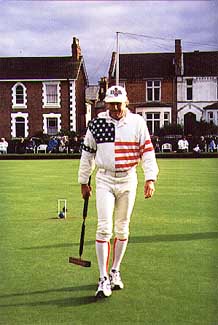
|
| Mehas just short of over-dressed for the finals in his characteristic garb. |
The problem emerged in the semi-final between Mehas and Esmat. Mehas, accoutred in plus-2's and red and white socks left over from his baseball playing days, won his first game against the Egyptian champion. Esmat came back and leveled the score. By now the partisan support from Egyptians and Americans in the crowd became highly vocal. Spectacular play kept the crowd spellbound, while both players hit in time after time from long distances to take their opponent out of hoop-running position.
Tension mounted as the third and deciding game took shape. Esmat bagged an early lead, only to be hauled back by Mehas, leveling the game at four-all. By this stage both players were being noisily cheered on by their fellow players and compatriots. When a questionable referee decision went against Mehas, one American fan disagreed too loudly, and with the wrong words. (Mehas describes the incident in the interview at the end of this article.) The Tournament Referee, Tony Hall of Australia, quieted things down with the unusual application of a "yellow card." (The yellow card is a warning; if followed by a red card, the offender is out of the event.)
Soon after "the incident," Mehas took the match with a spectacular hoop shot from the peg to win a place in the final against Younis, who had brought Newell's extraodinary run to a crushing halt, beating the upstart Irishman handily in two games.
The final between Younis and Mehas was played as a best-of-five match. In the first game, Younis, a slim physical education teacher from Cairo with an immaculate swing, uncharacteristically showed his nerves, losing the game 7-5. Mehas made the winning hoop from five yards, with the Egyptian's next ball in position to run the hoop had Mehas missed.
The second game was one-sided, with Younis coming into his stride in a succession of long hoops, effectively closing the American out of the game, 7-1.
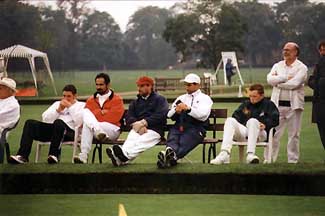
|
| These spectators at the finals are respectfully silent, in contrast with their raucus display in the semis. |
The fourth game continued in the same style, but as darkness encroached and the arc-lights were turned on, the longer experience of the Egyptian showed through, and to the delight of his numerous compatriots watching the match, Khaled took the final game +3 to regain the world championship title he had first won in 1996.
In the play-off for third place, Evan Newell delivered another defeat to Yasser Esmat, winning his trophy in three games.
The hosts - the Warwick District Council - provided a Championship Dinner after the final matches, at which all the players were presented with engraved crystal glass tumblers as a memento, and Younis, Mehas, and Newell were given their trophies.
The players were not as generously hosted in England as they had been in Italy in the first year of the championship, or in Egypt last year. While the WCF makes a baseline request for a one thousand pounds sterling license fee for the event as well as a commitment from the hosts to provide player accommodations, in this case free lodging was not included, and players paid their own bills for staying at the Regents Hotel, some eight minutes' walk from the courts.
When asked about the quality of the hosting, Bill Arliss, Head of Council of the English Croquet Association, commented, "From what I saw at Leamington, they made a very good job of things, and I have already written to Chris Hudson, congratulating the WCF on what they achieved." Arliss stated that the CA was not itself directly involved in the negotiations of the WCF with the Warwick District Council hosts. "For those concerned about the lack of paid accommodation and outside entertainments, I would ask them to consider the basic economics of the situation. Our national government has decided that minor sports such as croquet will not be supported in future, and from next year we shall no longer receive grants from our Sports Councils. Businesses and local governments take a similar view, seeking other avenues for their sponsorship to give them better returns on their investment. Having been through this process myself for the 1997 European Association Championships, I am fully aware of the tremendous difficulties in getting any sponsorships at all."

|
| What could these seated British giants be thinking as they watch the finals? They are (starting second from left then left to right) Robert Fulford, Keith Aiton, and David Openshaw. |
By all reports, there is surprisingly healthy competition to host the next Golf Croquet World Championship - from Australia, South Africa, and America. WCF officials will give no clue as to which of these bids, if any, has an inside edge, or whether, for that matter, player accommodations are likely to be included.
Rules due for revision by early 1999
What is certain about the next championship is that it will be played with a freshly revised set of official WCF rules. Tony Hall, chair of the WCF working party on the rules, confirms that at least 20 revisions are in the works following review of all the feedback from the Leamington games. The game which started as Egyptian Golf Croquet is now "WCF Golf Croquet." There are significant differences between the two games, Hall asserts, although in essential respects they are very similar. (The rules are published in their entirety in CROQUET WORLD ONLINE MAGAZINE's Game Department, and the new revisions will be incorporated as soon as Hall's committee makes them available.)
Will the style of play change along with the rules?
Mehas told me, before embarking for England, "I'm a good shooter, I hit well, I just don't hit rockets the way they do. But you' ve got to hit straight, no matter how hard you hit. I'm going to play the game I know, I'm not changing anything, I'm just not going to knock the fences down, the way they do."
If Mehas learned some things from the Egyptians, perhaps they learned something from him too - the delicate blocking and wiring shots so critical to Mehas' "out-ball" American Rules game. These "touch shots" often come into play in American Rules Golf Croquet and other varieties of the game, but they have not widely exploited so far in WCF Golf Croquet, because the Egyptians have not cultivated them - and for good reason. The relatively low standards of their court surfaces are not friendly to delicate finesse strokes. But now, if the game is destined to be played on the world stage on good lawns, where finely calibrated touch shots will work, hard hitting will be relatively less important.
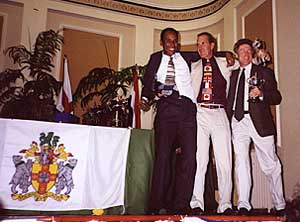
|
| Accepting the applause at the trophy presentation are winner Younis of Egypt, second place Mehas of the United States, and third place Newell of Ireland. |
Furthermore, Kamal told me, "It might surprise you that the Egyptian team was stronger than the two previous Egyptian teams. I know for a fact that the problem facing Egyptian croquet is the lack of emphasis on the tactics and the continuous concentration, instead, on the hard, accurate shooting. Exactly like a basketball player practicing slam dunks and ignoring the fundamentals of the game. That is how Mik and some of the European players were able to beat many of the Egyptians, once they started to figure out some tactics and tricks."
What about the "perfect courts" issue? "The perfect courts definitely helped the non-Egyptians," Kamal conceded, "but the reason is not because the Egyptians cannot play on perfect courts, but because the Egyptians failed to play smart and depended on one thing - shooting accurately."
Does Kamal think the rule changes will make a difference? "The differences are minor and would not affect the Egyptian dominance in the game. What will really endanger their dominance is their continuous disregard for the fundamentals. Khaled Younis agrees with this assessment."
Can more top players be lured into Golf Croquet?
The Egyptians have revealed their vulnerability. The big question now is: How many top-ranked players will follow Mehas into top-level Golf Croquet competion, to deliver a serious challenge to Cairo in the next world championship? Although Leamington Spa has upped the ante, the same factors rule the top players' agenda now as before: The scarcity of time is the most important of them. American Jerry Stark told me, "I don't even have time to play the American Rules game. If I want to beat Fulford and Clarke, I have to put my priorities on International Rules croquet." Starks believes he could be as good as the Egyptians at their game if he practiced it - but he's not sure, and he's not likely to find out, he says. He can't spare the time.
Former world champion Chris Clarke has similar considerations about time. Although Clarke acknowledges that he probably wouldn't be brilliant at the game because of his "variable shooting," he would be happy to play a test match against Egypt over a weekend "to put my abilities to the test." He shares the belief that "if our top players played Golf Croquet for a couple of weeks beforehand, they would have the edge" against the Egyptians.

|
| Mehas leads Younis in a high-spirited "victory dance" at the finals dinner. |
In his own words: Mehas at Leamington Spa
Mik Mehas - a rare player on many counts - is an exception on the time issue. He will take the time to compete. Among the top-ranked players in America, he is only one who plays in all the major events. There's little question that he will be "going for the gold" in the next WCF golf croquet world championship, wherever and whenever it may be.
After Mik Mehas returned from England with his trophy, I was able to interview him before he flew off to Palm Beach, where he was to successfully defend his national championship in International Rules. When we spoke, he was still high on his Leamington experience.
"The 'bad boy' tag you gave me in that article last year has really stuck over there," he told me, "so every time I made a hoop, it was "Bad boy, bad boy, bad boy!" from the stands. You wouldn't believe it. I got a three-minute standing ovation at the awards ceremony, and it was all, "Bad boy! Bad boy! Bad boy!", All chants, everybody was up doing that. They loved me! Because I would interact with the crowd, I was enjoying myself...."
But it couldn't have all been fun, I reminded him. There was the sensational "incident" that everybody wants to know about, in his semi-final game against the Egyptian Yasser Esmat. How did that happen?
"Yassar kept walking into my line of vision on shots, waving his arms, jumping up and down, and I would pause and look at him and wait for him to stop, so I was sometimes one minute, two minutes, and I was threatened with a yellow card about four times because of my "slow play", but they wouldn't do anything about him and his misbehavior.
"Anyway, I won the first game easy, I blew the second game, lost it 7-6. In the third game I was cruising along, I had just made two-back....Now get this, every time I made a hoop everybody except the Egyptians went crazy, everybody was rooting for the underdog - just the way people are for anybody but the Brits in Association Croquet because the Brits dominate the game.
"I made two-back, my ball went out of bounds, my opponent lagged up, real nice lag, about a foot in front of three-back, and so I lagged my other ball up, and he lagged up, and I figured I would take him out with my last shot. So this guy just walks right in front of me! And I looked at him, and I looked at the referee, and she kind of turned her back, and what I said to her was, "Get this **** off the court, or I'm gonna get you replaced!" Anyway, she got him off, waved him off the court, and I proceeded to drill that ball, right in the center, and the crowd went wild again.
"So I got that hoop, which put me up 5-4 at that point. So we get up to #10, four-back. He lagged up, I lagged up, and I knocked his ball out, I drilled his ball with my ball that had made three-back. So I'm right there in front. So he shoots at me and misses and goes out of bounds directly behind penultimate.
"So I made the hoop with my black ball, and I'm waiting for the referee to move the red ball back, because it was over the boundary, had to go back to the corner. But Yasser goes ahead and hits his yellow ball. So I went over and asked her, "Move the red ball back, I don't want him to have the shot from that position."
"But she said, 'It's too late.'
"I said, 'What do you mean, 'too late?' The rule is that you move the ball back unless I want it to stay there.' She wouldn't budge.
"So I summoned Tony Hall [ROT]. Tony says, 'You're right, Mik, she made a mistake, but it's her call.'
"She looked straight at me and said, 'I made my call. Play!'
"Tony said, 'But you made a wrong call.'
"But she said, 'I'm out here, and if he doesn't play, I'm going to yellow- card him right now.'
"So anyway, I played, and the worst thing is, he had laid his other ball up, it was wired from me, he'd blocked it, I would have had to do a pool hall thing to hit him, and I couldn't do it, and he won that point. He got that point at #11, and it was really distasteful. He got that point because of where he was after four-back, and because she [the referee] refused to move it back."
"That call pissed people off for about ten mintues while Tony was out there, and the crowd was yelling, 'Move it back! move it back!' because, it's a rule! The crowd was definitely on my side.
"And meanwhile, what I was doing was walking around, and every time Yasser would make a shot the Egyptians would yell, 'Bravo! Bravo!' and I would yell 'Bravo! Bravo!' too, because the guy's a good shot, he was great, he just drove me from all over, outstanding shot. And people were asking my teammates, 'Doesn't he care? He goes and sits down in the middle of the match, he just laughs and claps, doesn't he care?' But I'm having fun with this guy. Because all this stuff, the crowd, it fires me up. I love it! It's not like Association Croquet, where everybody just sits there on their thumbs. People are clapping and up and down yelling and....it's great!
"So anyway, he makes the hoop there at #11 and he winds up with a hoop shot at #12 with his blue ball; I laid red up there, then he laid black up and had me wired. So I'm sitting there at the stake with my yellow ball, he has both blue and black in position to run the hoop, and I just took aim and swished that rover hoop, right down the middle, and ended it, 7/5.
"And then Ihab and about fifty other people were out on the court running around, just going crazy that I beat him.
"So the Egyptians were yelling in Egyptian at Sherif and Ihab [American teammates and brothers] because they were pulling for me. And I guess Sherif yelled back something that wasn't especially polite, so they yellow-carded Sherif for his language - although from what I heard from some people, what Sherif said was nothing compared to what THEY were saying.
"So by that point, it was really like a war thing, Egypt versus the USA - far beyond just two guys playing. So before the final match, the referee got us in there, myself and Khaled Younis, before the final match, and said, 'We don't want to have any incidents here like yesterday, we just want two players playing against each other.' And we had no problem with that. Younis is a first-class gentleman, a good player, and a fine athlete.
"The final went smooth, I just blew it. The biggest problem was the prospect of playing in the darkness. [Most Mehas matches had taken over an hour a game; at that rate, the final match could last well into the night.] He hits in better than I do, he could do well in Association. But my hoops are better than his.
"By the end of the third game, it was beginning to get dark, and they brought three arc lights out there, they're either in your eyes or turned the other way, in either case you couldn't see. There was no good reason to start that late when there was plenty of court space to start earlier. They said they had to start at that time because that is what they had advertised."
I asked Mehas about the hard hitting of the Egyptians. "They're used to hard hitting because of the poor quality of their courts. They would go down there to the next hoop, as soon as you lagged up, they'd put you in space. So I was very conscious of this, after a guy made hoop #3, hard, he'd be sitting on the end line behind hoop 4, I'd lag up, the other guy would lag up. and from the end line, he'd put me in orbit.
"So I soon became very careful about lagging up and WIRING to that ball on the end-line. And that's stuff these guys didn't do. It's like American Golf Croquet. That's the reason I did so well, not American Golf Croquet, but because I play my out-game, every time, in America Rules. So at Hoop #1 in American Rules, basically, that's Golf Croquet, and I've had plenty of practice doing that, in every American Rules tournament I play.
"At Leamington, I learned how to play their game in the qualifying blocks, where I got beat by both Egyptians in my block. But I learned how to play their game. Egyptian Golf Croquet is totally different from any other kind of Golf Croquet. It's a different game, where if they're 30, 35 feet away, 80 percent of the time, they're going to hit you off the other end of the court! It's a monster.
"But I do believe that what I did will help to attract Association players to the game. They'll say, 'Hell, if Mik can do it, I can do it.'"
How did Mehas prepare for Leamington? "I had one day with Mohammad Kamal out there in Beverly Hills, and one day with Ihab, when he flew in and we played six games. So that was my total experience.
"Strategy-wise, Younis was way ahead of me. He knew how to promote the balls. For example, they lay up in the jaws lots of times, then bring the other ball to the back side, so as soon as they got through, their partner ball could pop them to position for the next hoop. They were good at that, and I didn't do well at that kind of tactic. The guy who beat me in the finals has been playing this game - and only this game - for 13 years.
"And what he also did was control all four corner hoops on me. Every time I had a ball up there, he would hit and knock them both out of bounds, and when they're both out of bounds, you can't hit it. So he would sit there, and he'd have a seven-yard shot no matter what I did. So I was shooting at a lot of hoops from the end-line. Because if I had anything closer than that, it was gone!
"From the American game, I learned to lay up and wire. Everything else, I had to learn from the Egyptians. And the Egyptians were all gentleman - except for the one guy, and you'd have to use a different word for him.
"I like this game because of the emotional incentive. It's like a baseball game: You can go in there and bust up a double play in this game. It's just part of the game.
What about the other non-Egyptians who did well? "Donati is smart. He lags well. You can't explain the Irishman, Evan. Everybody had beaten him in the Irish championship. But he came to Leamington with a leprechaun on his shoulder, unbelievable, he just smoked everybody.
What Americans could excel in WCF Golf Croquet? "Jacques [Fournier] could do well at this game, any good one-ball shooter could. Jim Houser is a smart kid, he's bright, and he played smart. Sherif and Ihab are blasters, they play just like they grew up playing. Although not all the Egyptians are blasters, just most of them. There are about three finesse guys among the Egyptians, and the rest are blasters. Last year's champion was not a blaster."
Major media could make all the difference
For a decade or more, organizers in various countries have attempted to get major television coverage for croquet. Such a venture captured some attention in England in the late eighties, but it failed the ultimate test: No one was tempted to repeat it.
The simpler and faster game of Golf Croquet, however, recommends it for the same kind of treatment. A recent conversation on the Nottingham board explored the possibilities at some length. Although opinions are mixed, there is clearly a consensus forming in favor of a serious push for WCF Golf Croquet on television.
When Stephen Mulliner was on the Council of the Croquet Association, he spearheaded the effort - which failed narrowly - to recommend Golf Croquet to the producers of a national croquet telecast, instead of "Association" Croquet. He explains the still considerable opposition to telecasting Golf Croquet. "The anti-Golf Croquet traditionalists", he said, "fear that development of Golf Croquet might reduce the appeal of Association Croquet. Opposing parties agree that Association Croquet should be retained and fostered and both agree that Golf Croquet is capable of being exploited because of its inherent televisual advantages."
Mulliner and other influential observers believe that a winning combination of fast-paced Golf Croquet, television, sponsorship, and prize money to draw star players and media attention could succeed in the marketplace and begin to turn the tide towards a more favorable public perception of the sport - especially if you throw into the mix a few celebrities. "Change will come about through market forces," Mulliner predicts. "Either a future Golf Croquet World Championship will be organized with an explicit brief to attract sponsorship and prize money or an independent tournament will be organized."
These possibilities are not lost on Chris Hudson, Secretary General of the World Croquet Federation, who made prominent reference to the potential mass media appeal of WCF Golf Croquet in our E-mail interview. "Spectators without exception said they found the game interesting and exciting. The semi-final, between Mik Mehas and Yasser Esmat, produced tremendous partisan audience participation, with great spectator appeal. TV would have loved it, particularly the players gesticulating at each other, and the application of the 'yellow card' to a spectator by the tournament referee."
While traditionalists may be appalled by the image of competitive croquet imitating the rowdiness of spectator sports like boxing and baseball, Hudson seemed delighted by the prospect: "This type of croquet fully justifies the players and officials being introduced to the crowd, as in a boxing match. We actually did this, and it seemed entirely appropriate."
Hudson, who has a long and distinguished record as an organizer, including a stint as Development Officer for the Croquet Association, is among the most enthusiastic promoters of Golf Croquet as a vehicle for broadening the appeal of the sport. "Experience from England in selecting players for the three World Golf Croquet Championships held so far would seem to indicate that Golf Croquet attracts a different type of player. If this is indeed so, it is good news for croquet generally, as it must mean that by promoting Golf Croquet, our existing national associations can effectively double or even treble their memberships."
The winning formula: Golf Croquet, prize money, sponsorship, major media
It's a reasonable statement, although local organizers may face the biggest opposition on their own local courts, from veteran players who do not shrink from expressing their contempt for the "lesser form" of croquet and those who play it. Change may have to come from the top down. If top-ranked players take up the game, if sponsors can be persuaded to invest, if signficant prize money is put up, and if all these elements are combined with major television coverage, Golf Croquet could transform the sport and the entire croquet culture - in sheer numbers of players, courts, facilities, and most of all, in popular public perception.
If such a transformation occurs, it seems most likely to begin in the United States. That's where the big money is, and the big media, with a dizzying array of cable channels which continue to multiply along with a voracious demand for new and varied content. Bob Kroeger, America's best known teaching pro and chairman of the USCA Selection Committee, is just as enthusiastic as Mulliner and Clarke about the game's future: "I think the Leamington event is one of the most important for the croquet world. This is a game that could be sold to the masses. Played at the world-class level, it is an exciting, fast- paced, hard-hitting spectacle - Egyptian style.
"I have had the privilege of learning a great deal from Sherif [Abedelwahab, who lives near Kroeger in Massachusetts]," Kroeger goes on, "and viewing his spectacular footage from Egypt, I am completely sold on this version of the game. If a major prize money event could be created here in the U.S. (maybe with a celebrity pro-am tie-in), it would have a chance of attracting signficant media coverage. I know there are players who are against prize money, but it is one thing that attracts interest in sports. All major sports (and many minor ones) have money as the attraction, and as a result have become popular with the masses."
Kroeger also admires the game from his perspective as a teacher and organizer of novice-level revenue events. "It serves the player who doesn't want to spend two or three hours playing one game," he comments. "Golf Croquet's success in corporate outings is already proven - I've never heard of an unsuccessful corporate event in a Golf Croquet format. It's the logical game for introducing the sport to people with only a passing interest in the game. How often we have seen avid six-wicket players force their friends to try the advanced game, only to turn them off croquet completely!"
How signficant was the Leamington Spa championship in the scheme of things? If the event signaled a new era in the the true internationalization of the sport, as some observers believe, it was very signficant indeed. If the game can be used to create a breakthrough in mass media coverage, that could result in building the sport at every level, in local clubs and associations throughout the world.
Whether that is the real significance of the Leamington Spa event, only time will tell. If Chris Hudson of the WCF has anything to say about it, the croquet community will deliver their verdict sooner, rather than later. Although the WCF has so far been unable to mount another World Championship in International Rules following the last such event in Australia in 1997, bidding is already spirited for the next Golf Croquet World Championship, which seems to be on steady track as a annual event, following on the intial successes in Italy (1996), Egypt (1997) and England (1998) at Leamington Spa.
[CROQUET WORLD ONLINE MAGAZINE thanks the many contributors to this article, including a press release from the World Croquet Federation.]